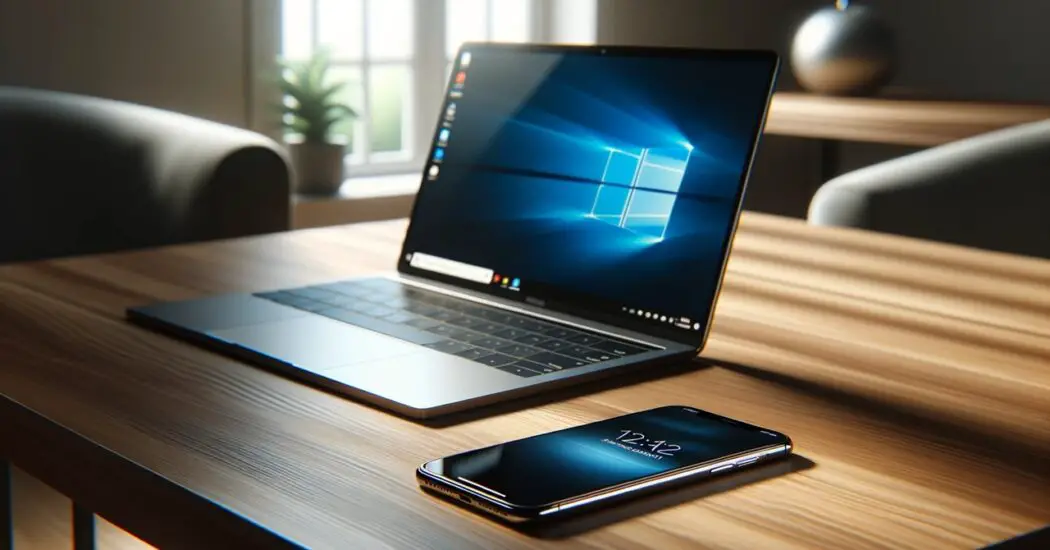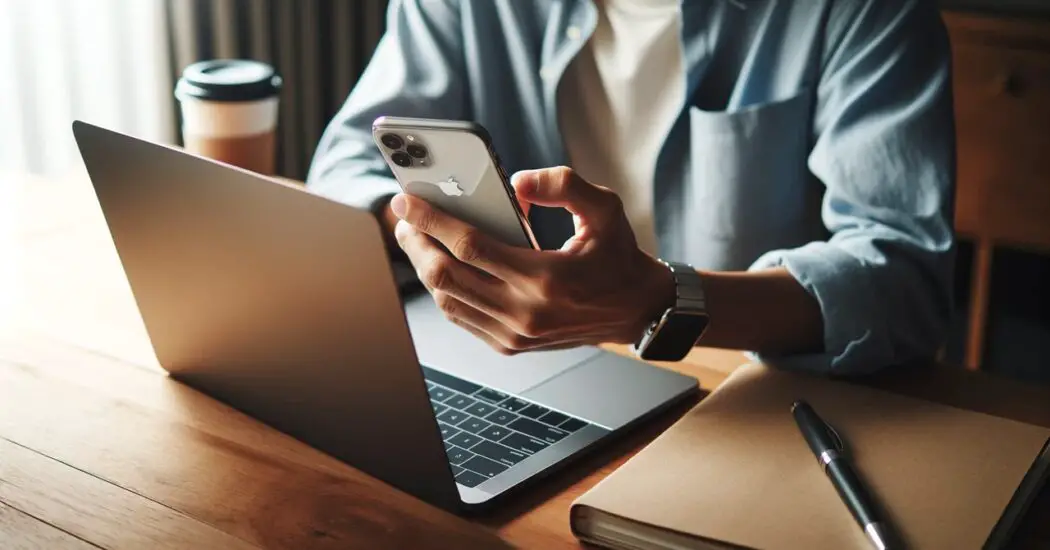Discovering how to use an iPhone camera as a webcam on Windows can enhance your video calling experience significantly. This transformation is not only possible but also straightforward, and we’ll guide you through each step to set up your iPhone camera as a reliable webcam on your Windows system.

Table of Contents
Understanding the Requirements
Embarking on turning your iPhone into a webcam for your Windows computer begins with a checklist of essential items. Ensure you have the following:
A Windows computer – This will be the platform where you’ll conduct your video calls or recordings, so confirm that it’s updated with the latest version of Windows to prevent any compatibility issues.
An iPhone with a functional camera – Any recent iPhone model with a working camera will suffice. The better the camera quality, the higher the quality of the webcam feed.
A stable Wi-Fi connection – Both your Windows computer and iPhone must be connected to the same Wi-Fi network. This ensures a stable and seamless connection between the two devices.
A commitment to follow the steps – Patience and attention to detail are crucial, as you’ll need to follow each step closely to ensure a successful setup.
Once you have all the requirements in place, you’re set to proceed with the setup process.
How to Use an iPhone Camera as a Webcam on Windows
Follow the steps below to use an iPhone camera as a webcam on windows…
Step 1: Installing the Required App on Your iPhone
The journey to transforming your iPhone camera into a webcam starts in the App Store. Here’s what you need to do:
Unlock your iPhone and open the App Store – this is where you’ll find the apps that can turn your iPhone into a webcam.
Use the search function at the bottom of the screen – tap on it and type in ‘webcam’ to find the relevant apps. Look for apps with high ratings and positive reviews to ensure reliability.
Select a webcam app – ‘EpocCam’ and ‘iVCam’ are two reputable apps that serve this purpose well. They have been designed specifically to connect your iPhone camera to your Windows computer and use it as a webcam.
Tap on your chosen app – once you’ve made your selection, tap on the app to view its details.
Download and install the app – tap on ‘Get’ or the download button. You may need to verify your identity with Touch ID, Face ID, or your Apple ID password. Wait for the app to download and install on your iPhone.
Step 2: Installing Companion Software on Your Windows Computer
After setting up the app on your iPhone, your next action is to create a bridge that enables your Windows computer to communicate with your iPhone. This is where companion software comes into play. To install this essential component, please follow these detailed steps:
Open your preferred web browser on your Windows computer. This can be Microsoft Edge, Google Chrome, or any other browser you’re comfortable with.
Navigate to the official website of the webcam app you have installed on your iPhone. Ensure you’re visiting the official site to avoid any security risks that come with downloading software from unreliable sources.
Locate the download section on the website, and look for the Windows version of the software. It’s essential to choose the version that corresponds to your Windows operating system (32-bit or 64-bit).
Click on the download link. You might be prompted to save the file. Choose a location you can easily remember, like your desktop or downloads folder.
Once the download is complete, locate the installer file. It will usually end with ‘.exe’ and can be found in the location you chose to save the file.
Double-click on the installer file to run the installation process. If prompted by Windows Security, click ‘Run’ to confirm that you trust the source of the software.
Follow the on-screen instructions to install the software. This typically involves agreeing to the terms of service and selecting an installation directory.
Wait for the installation to complete. It should only take a few minutes, depending on your computer’s performance.
With the companion software successfully installed on your Windows computer, you’re ready to connect your iPhone to your computer.
Read more iPhone camera topics here – iPhone Camera: How To, Problems & Solutions
Step 3: Connecting Your iPhone to Your Windows Computer

The connection process is crucial for turning your iPhone camera into your new webcam. Here’s how to ensure a smooth connection:
Start by opening the webcam app you installed on your iPhone.
Then, proceed to your Windows computer and open the companion software you just installed.
Before moving forward, double-check that both your iPhone and Windows computer are connected to the same Wi-Fi network. This step is crucial because the devices need to be on the same network to communicate with each other.
On your iPhone, the app will usually automatically search for any available computers on the network. Give it a moment, and your Windows computer should appear on the list.
Once you see your computer’s name appear on your iPhone, tap on it to select it. This action initiates a request to connect to your computer.
Your Windows computer might prompt you to allow the connection. Go ahead and confirm this to establish the link.
Step 4: Configuring Video Settings
With the connection established, it’s time to tweak the settings to enhance your video quality for your needs. Here is how to fine-tune the visual details:
On your iPhone, access the webcam app you previously installed. Within the app, you should find a settings or preferences section. This is typically represented by a gear icon or can be found in the app’s menu.
Once you’re in the settings, look for video-related options. Here, you will often find a variety of adjustments you can make. Common settings include resolution, where you can select the sharpness of the video. Higher resolutions offer more detail but may require a faster Wi-Fi connection for smooth streaming.
You might also see options for changing the orientation (portrait or landscape) depending on how you have your iPhone positioned.
Other settings could include frame rate (how smooth the video will appear), color balance, and even the choice to use the front or back camera of your iPhone.
Adjust these settings to meet the demands of your environment and personal preferences. If you’re unsure, starting with default settings and adjusting from there as you test the video feed can be a good approach.
After configuring the iPhone app, move over to the Windows software:
Open the companion software on your Windows computer.
Similar to the app on your iPhone, navigate to the settings or preferences section.
Here, you can usually synchronize settings with your iPhone or make additional adjustments that affect how the video feed is rendered on your computer.
Settings may also include options for adjusting brightness, contrast, and potential filters or effects you wish to apply.
Step 5: Integrating with Video Calling Software
Now that your iPhone is ready to serve as your webcam, the final step is to integrate it with the software you’ll be using to make video calls. Here’s how to complete the integration:
Open your preferred video calling software on your Windows computer. This could be a platform like Skype, Zoom, Microsoft Teams, or any other service you use for video conferencing.
Find the settings or options menu. In most applications, this will be under ‘Tools’ or a similar menu, sometimes represented by a cogwheel icon.
Navigate to the video or camera settings within your video calling software. This section is where you can select your video source.
Look for a dropdown menu or a list of available cameras. You should see your iPhone listed as one of the options, often under the name of the app you installed (e.g., EpocCam or iVCam).
Select your iPhone from the list. Once selected, you should see a preview of the video feed from your iPhone’s camera.
Make sure everything looks good in the preview, and adjust your iPhone’s position as necessary to frame your shot just how you like it.
Troubleshooting a Common Issue
Despite your best efforts, sometimes technology can be temperamental, and you may run into hiccups while using your iPhone camera as a webcam. Here’s a guide to calmly and effectively resolving a common issue you might encounter:
Issue: The Camera is Not Being Recognized
Check Network Consistency: The most common culprit is a network discrepancy. Verify that both your iPhone and your Windows computer are connected to the same Wi-Fi network. This is a critical step, as differing networks can prevent your devices from communicating with each other.
Restart the Applications: If the network isn’t the issue, try a soft reset of the software. Close the webcam app on your iPhone and also exit the companion software on your Windows computer. Wait for a few seconds, then relaunch them. This can often refresh the connection and resolve temporary glitches.
Reboot Your Devices: If restarting the apps doesn’t do the trick, reboot both your iPhone and your computer. On your iPhone, hold down the power button and either volume button, then slide to turn off. On your Windows computer, click on the Start menu > Power icon > Restart. A fresh start can clear out any minor software issues that may be causing problems.
Confirm App Permissions: On your iPhone, go to Settings > Privacy > Camera/Microphone and make sure that the webcam app has permission to access them. Without these permissions, the app won’t be able to capture video or audio.
Check for Updates: Ensure that both the iPhone app and the Windows companion software are updated to the latest version. Software updates often fix bugs and compatibility issues.
Reinstall the Applications: If all else fails, uninstall the webcam app from your iPhone and the companion software from your Windows machine. Then, reinstall them fresh from the App Store and the official website, respectively. This can rectify any corrupted files or installation errors that might have occurred during the initial installation.
Consult Support Resources: Look at the FAQ or support section of the app’s official website. Many common issues are addressed here, and you might find a solution tailored to the problem you’re experiencing.
Wrapping Up: How to Use an iPhone Camera as a Webcam on Windows
You’ve now successfully set up your iPhone camera as a webcam on your Windows machine. With a bit of patience and following these steps, you can enjoy a significantly better video calling experience. For any additional assistance, refer to the FAQ sections on the app’s official website or reach out to their support team.